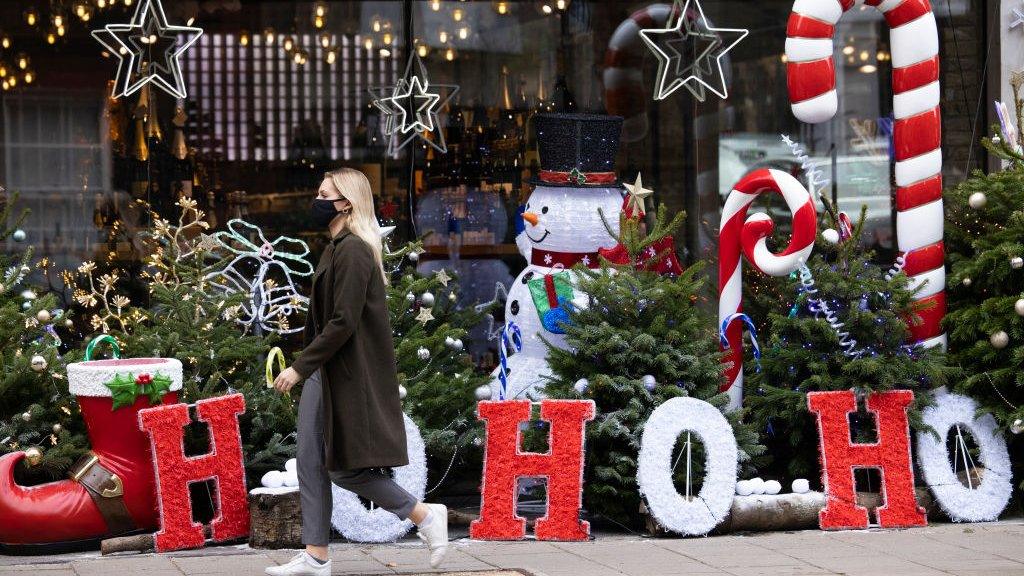Covid: New restrictions start - which tier are you in?
- Published
- comments

A new three-tier system of coronavirus restrictions have come into effect in England.
It follows the four-week national lockdown across England.
The tougher restrictions have been brought in by looking at factors such as weekly cases of coronavirus.
The majority of people in England will be in the strictest two tiers and cannot mix indoors with other households.
The system will be regularly reviewed and an area's tier level may change before Christmas - the first review is scheduled for 16 December.
Prime Minister Boris Johnson said the "tough measures" are the best way to avoid a "new year lockdown", and that "if we're going to keep schools open, our options are limited".
He added: "The faster we can drive it down the faster we can lift the restrictions - and that is what the tiers are designed to achieve."
He says the previous tiers system slowed infection rates but "were never quite enough" which is why the new ones are a bit stricter.

Health Secretary Matt Hancock said: "We're approaching the end of a year where we've asked so much of the British people, and in response to this unprecedented threat, to lives and to livelihoods, the British people have well and truly risen to the challenge by coming together to slow the spread and support each other.
"I know how difficult this has been, especially for those areas that have been in restrictions for so long.
"We must protect our NHS this winter,"
Wherever you live in England, non-essential shops selling things like clothes or games can reopen, as can hairdressers and leisure centres. Meanwhile grassroots sport will be allowed again.
Medium / Tier 1: Rule of six if meeting indoors or outdoors; pubs and restaurants shut at 11pm.
High / Tier 2: No household mixing indoors; rule of six applies outdoors; pubs and restaurants shut at 11pm.
Very high / Tier 3: No household mixing indoors or outdoors in hospitality venues or private gardens; delivery and take-away only for restaurants, indoor entertainment venues closed.
Scotland, Wales and Northern Ireland have their own rules to reduce the spread of coronavirus.
People across the UK will be allowed to form a Christmas bubble for five days from the 23 December, where up to three households can come together to celebrate.
So which areas are in which tier?
Tier 3

Areas in the highest level of local restrictions - tier three - include Birmingham, Leeds, Sheffield, Tees Valley Combined Authority and North East Combined Authority.
Greater Manchester, Lancashire, Leicester, Lincolnshire, Slough, Bristol, Kent and Medway will also be in tier three.
People living in Tier 3 will face the toughest restrictions with strict rules over where people are allowed to meet up.
North East
Tees Valley
Hartlepool
Middlesbrough
Stockton-on-Tees
Redcar and Cleveland
Darlington
Sunderland
South Tyneside
Gateshead
Newcastle upon Tyne
North Tyneside
County Durham
Northumberland
North West
Greater Manchester
Lancashire
Blackpool
Blackburn with Darwen
Yorkshire and The Humber
The Humber
West Yorkshire
South Yorkshire
West Midlands
Birmingham and Black Country
Staffordshire and Stoke-on-Trent
Warwickshire, Coventry and Solihull
East Midlands
Derby and Derbyshire
Nottingham and Nottinghamshire
Leicester and Leicestershire
Lincolnshire
South East
Slough (remainder of Berkshire is tier 2: High alert)
Kent and Medway
South West
Bristol
South Gloucestershire
North Somerset
Tier 2

The Liverpool City region was the first to go into Tier 3 when the regional restrictions was announced back in October, however under the latest set of rules the area is now in Tier 2.
Health Secretary Matt Hancock thanked the people of Liverpool for "following restrictions".
The Health secretary also praised the results of a community testing programme in the city of Liverpool.
The result is that in the Liverpool city region cases have fallen by more than two-thirds. And in the borough of Liverpool itself, where the mass testing took place, cases have fallen by three-quarters.
North West
Cumbria
Liverpool City Region
Warrington and Cheshire
Yorkshire
York
North Yorkshire
West Midlands
Worcestershire
Herefordshire
Shropshire and Telford & Wrekin
East Midlands
Rutland
Northamptonshire
East of England
Suffolk
Hertfordshire
Cambridgeshire, including Peterborough
Norfolk
Essex, Thurrock and Southend on Sea
Bedfordshire and Milton Keynes
London
All 32 boroughs plus the City of London
South East
East Sussex
West Sussex
Brighton and Hove
Surrey
Reading
Wokingham
Bracknell Forest
Windsor and Maidenhead
West Berkshire
Hampshire (except the Isle of Wight), Portsmouth and Southampton
Buckinghamshire
Oxfordshire
South West
South Somerset, Somerset West and Taunton, Mendip and Sedgemoor
Bath and North East Somerset
Dorset
Bournemouth
Christchurch
Poole
Gloucestershire
Wiltshire and Swindon
Devon
Tier 1

Only a few areas have been placed into Tier 1 and they include places with the lowest number of coronavirus cases - such as Cornwall, the Isle of Wight and the Isles of Scilly.
The Health Secretary Matt Hancock thanked people living in those areas for their "vigilance" and asked people living across England not to see the tier rules "as a boundary to push" but a limit as to what they can do.
Adding that it is "on all of us" to help reduce the spread of the virus.
South East
Isle of Wight
South West
Cornwall
Isles of Scilly
- Published25 November 2020

- Published23 November 2020

